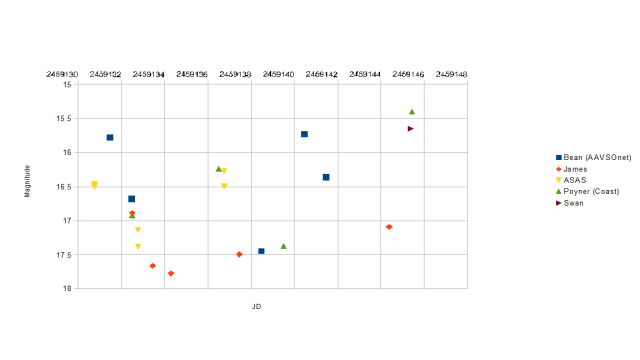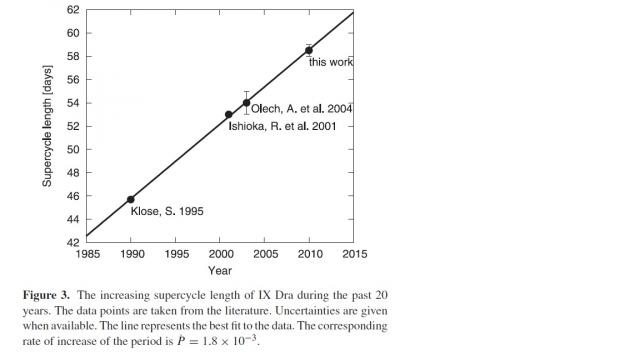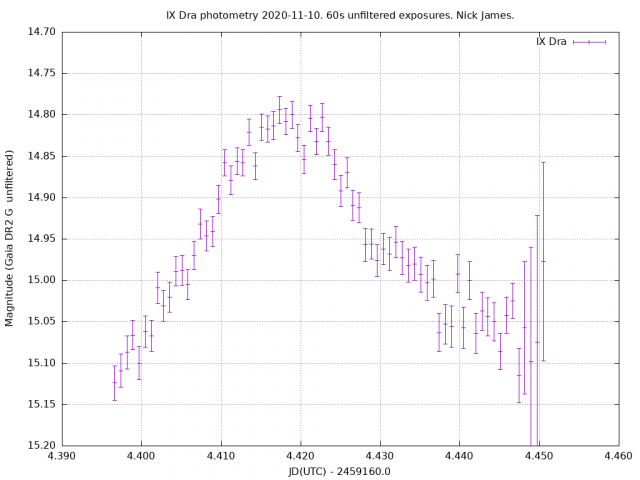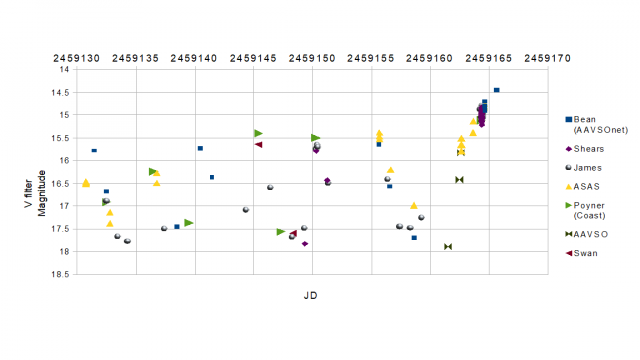› Forums › Variable Stars › IX Dra: observations requested
- This topic has 64 replies, 8 voices, and was last updated 3 years, 1 month ago by
 Jeremy Shears.
Jeremy Shears.
-
AuthorPosts
-
9 October 2020 at 10:08 am #574756
 Jeremy ShearsParticipant
Jeremy ShearsParticipantIX Draconis is dwarf novae of the ER UMa type. The V magnitude of the star varies between 14.6-18.2 mag. It undergoes very frequent “normal” outbursts, with typical recurrence times in the range 3 to 4 days. Superoutbursts occur regularly with a supercycle length (Psc) of ~ 60 days. Studies have shown that the Psc is increasing.
Recent data from TESS have revealed the light curve of IX Dra in exquisite detail. However, for the next few months IX Dra will not be monitored by TESS. In the meantime, Stewart Bean (BAA VSS) and I are keen to get timings of the start of the next superoutburst (due early November) and possibly the one after that.
Please could observers add IX Dra to their target list. We are requesting one observation per night to get a light curve which will enable us to spot the normal and superoutbursts. Observations can be visual or CCD (Clear is fine, or V) .
Please submit your observations to either the BAA VSS database or the AAVSO’s.
Charts and sequences are available from the AAVSO website. IX Dra is located at RA 18 12 31.47 Dec +67 04 45.8 (J2000.0)
Many thanks in advance,
Jeremy Shears & Stewart Bean.
20 October 2020 at 7:06 pm #583266 Jeremy ShearsParticipant
Jeremy ShearsParticipantThanks for the update, Stewart. Certainly a lively star!
22 October 2020 at 11:29 pm #583273 David SwanParticipant
David SwanParticipantMeasured IX Dra at 15.650 CV this evening, 2020/10/22 21:07 UT.
23 October 2020 at 10:36 am #583265 Stewart John BeanParticipant
Stewart John BeanParticipantThe graph summaries the results to date.
There seem to have been three normal outbursts at 3-5 day intervals reaching 16.5 magnitude (V) at peak. The project is trying to time the next superoutburst to check the apparently regular 61+-2 day period suggested by TESS results. The next superoutburst is likely in the middle of November. If we can maintain observations at this frequency then we will have an uncertainly of only a day of two. Thanks to all observers who have contributed. Bean data is courtesy of AAVSOnet.
Stewart and Jeremy
 23 October 2020 at 2:37 pm #583275
23 October 2020 at 2:37 pm #583275 Gary PoynerParticipant
Gary PoynerParticipantYep, certainly in outburst Oct 22.944 15.4 visual.
Gary
26 October 2020 at 9:24 am #583274 Stewart John BeanParticipant
Stewart John BeanParticipant
 Thanks . That fits with the normal outbursts being about 5 days apart before a superoutburst. In the attachment from TESS data you can see the normal outbursts become more intense and 4-5 days separation. IX Dra never really goes into quiescence. Stewart26 October 2020 at 9:43 am #583290
Thanks . That fits with the normal outbursts being about 5 days apart before a superoutburst. In the attachment from TESS data you can see the normal outbursts become more intense and 4-5 days separation. IX Dra never really goes into quiescence. Stewart26 October 2020 at 9:43 am #583290 Stewart John BeanParticipant
Stewart John BeanParticipantToday I noticed the graphs had gone from my posts . I have put the latest back into the 26th Oct post. Any thoughts on the reasons? Are some formats preferred?
Nick James, Gary Poyner and David Swan all report IX Dra at fainter than 17 over the weekend. So back to its low state for a day or so. We can expect a few more normal outbursts at 4-5 day intervals before the super outburst around Nov 14th ( I’m sticking my neck out a bit here, I know).
Stewart
26 October 2020 at 11:48 am #583291 Robin LeadbeaterParticipant
Robin LeadbeaterParticipant“Today I noticed the graphs had gone from my posts . I have put the latest back into the 26th Oct post. Any thoughts on the reasons? Are some formats preferred?”
file size perhaps? jpg of graphical images tend to be larger and poorer quality than png for example
Robin
27 October 2020 at 7:17 pm #583303 Jeremy ShearsParticipant
Jeremy ShearsParticipantBright tonight: Oct 27.791 15.79C
3 November 2020 at 11:50 am #583331 Stewart John BeanParticipant
Stewart John BeanParticipantThe V filter observations graph below shows the current status as we approach an expected superoutburst in roughly two weeks time. With the frequency of observations achieved during this campaign, it should be possible to time the the superoutburst to within one day. This in turn should allow a fairly precise value for the superoutburst period to compare with literature values. The literature graph below implies a supercycle length of about 65 days for 2020 whilst TESS results, from 2019, suggest 61 days.

The observations below may not be complete so apologies in advance. Six normal outbursts at 5 day intervals have been recorded. The superoutburst is expected to reach 14.5 during November.
Thanks to all contributing.
 6 November 2020 at 1:03 pm #583344
6 November 2020 at 1:03 pm #583344 Stewart John BeanParticipant
Stewart John BeanParticipantThe AAVSOnet SRO telescope in Arizona suggested a V mag of 17.7 last night – so a low state.
One week to 10 days to go before the super outburst.
Regards
Stewart
9 November 2020 at 12:13 pm #583349 Stewart John BeanParticipant
Stewart John BeanParticipantASAS-SN reports IX Dra at magnitude 15.6 in its green channel for 2459162.6 : so back to a high state. When in superoutburst ASAS-SN has recorded magnitudes in the 14.5 to 15 range.
The UK weather forecast seems a bit Novemberish with cloud on all days this week for Cambridgeshire. Fortunately, there is good weather forecast for the AAVSOnet SRO, Arizona telescope for the week ahead.
I’ll keep you posted.
Stewart
9 November 2020 at 7:06 pm #583350 Dr Paul LeylandParticipant
Dr Paul LeylandParticipantThe LP weather forecast is also a bit Novemberish, i.e. typical for the rainy season. Tonight is a washout and we will be returning back to the UK on Friday, assuming Iberia doesn’t cancel our flights a third time, but I will see what I can do.
10 November 2020 at 5:11 am #583351 David SwanParticipant
David SwanParticipantConditions in NE England have been terrible over the past week: lots of mist and fog. If the Met Office forecast is right, there may be the odd break over the next few days. I’ll be sure to do measurements if conditions permit.
10 November 2020 at 6:54 pm #583353 Nick JamesParticipant
Nick JamesParticipantI get 14.87 tonight (2020-11-10.8) which is the brightest I’ve seen it. All of my recent obs are in the VSS database.
10 November 2020 at 10:57 pm #583354 Nick JamesParticipant
Nick JamesParticipantHere is one of the superhumps from tonight. Unfortunately the sky clouded over at the end of this run.
 10 November 2020 at 11:03 pm #583355
10 November 2020 at 11:03 pm #583355 David SwanParticipant
David SwanParticipantI measured IX Dra = 14.926 CV at 2020/11/10 22:33 UT.
12 November 2020 at 2:24 pm #583358 Stewart John BeanParticipant
Stewart John BeanParticipantThe anticipated superoutburst has been detected. Superhumps are confirmed. I estimate the outburst started at 2459162.5 and should continue for another 10 days or so. I have updated the graph and hope it is fully inclusive for all those have contributed.
The timing of this superoutburst gives an average period for the last 8 outbursts of 59.5 days. This value is close to the last reported value of 58.5+-0.5 from 2010 and suggests that the super outburst period has not really changed in ten years. I will stick my neck out and suggest that the next outburst will start near January 7th.
I think this has been a worthwhile exercise and would wish to thank all who have contributed.
Regards
Stewart Bean
 12 November 2020 at 6:29 pm #583359
12 November 2020 at 6:29 pm #583359 Jeremy ShearsParticipant
Jeremy ShearsParticipantThanks for the update, Stewart. It’s very nice result and my thanks to our observers, too.
I must admit this is not a star that I have observed before, but I will continue to do so as it’s always up to something. I hope others will do the same as we head towards the next superoutburst.
14 November 2020 at 10:04 am #583360 Stewart John BeanParticipant
Stewart John BeanParticipantIX Dra has been interesting for a newcomer like myself. It changes every five days or so and puts in a bright superoutburst fairly regularly. Following IX Dra might be a good New Years resolution.
I am going to follow ( from my desk as I do not have my own telescope) other UGER stars that are high in the morning sky: ER Uma, RZ Lmi, and DI Uma and are starting their observing season. These are also evolving fast enough to be rewarding. Gary Poyner recommended RZ Lmi as it is a good winter target and it has a superoutburst every ~20 days so there really is something happening every few days.
Stewart
-
AuthorPosts
- You must be logged in to reply to this topic.
